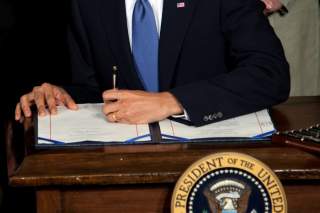The Slow Death of the Presidential Veto
The Bowe Bergdahl episode reveals an often-underscrutinized constitutional problem.
Lost in all the emotion unleashed by the Bowe Bergdahl episode is the disturbing question of how the U.S. government should deal with matters of constitutionality. It’s fine and good to fight this high-voltage Bergdahl matter out in the political arena, which ultimately can render a judgment on the wisdom or lack of wisdom in President Obama’s prisoner swap with the Afghanistan Taliban. But did Obama break the law in pursuing that swap, which involved Guantanamo prisoners, given that Congress had enacted legislative language requiring the president to notify Congress thirty days prior to any release of Guantanamo detainees? Or was that legislative language itself unconstitutional, thus giving the president leave to ignore it?
We’re in dangerous territory here. It’s dangerous, first of all, when Congress seeks to micromanage the president on matters related to his constitutional powers to wage war. The Framers gave Congress the sole responsibility for declaring war, which is an awesome responsibility that Congress has seen fit to shirk in many respects in recent decades. But, once we are in a war, the president has the responsibility, as Commander in Chief, for waging it. He can’t do so if he is encumbered by Congress on how he must exercise the small points of his military responsibility.
When and how to repatriate a lost soldier certainly fits within that jurisdictional area that belongs to the president. So does the matter of how to deal with prisoners of war, though it seems reasonable that the president should be subject to broad policy injunctions from Congress on how to treat those who are captured.
Thus, Congress’s thirty-day requirement raises serious constitutional questions, as Obama emphasized when that thirty-day legislation, buried in a much broader defense-authorization bill, reached his desk. He issued a “signing statement,” saying that he felt the requirement was unconstitutional and hence he may ignore it in the future.
But why didn’t he veto it? The presidential veto represents one of the Constitution’s foremost protections against congressional activity that exceeds the bounds of the country’s founding document. Indeed, early presidents generally confined their veto decisions to matters that raised, in their minds, constitutional questions. It wasn’t until Andrew Jackson argued that, no, the presidential veto power represented more than just a protection against unconstitutional actions by the legislature. It was, rather, he said, a tool to maintain presidential prerogative and thus, a balance of power between the two branches. Still, he exercised his veto only twelve times during his eight-year presidency.
Grover Cleveland, who served two nonconsecutive terms in the 1880s and 1890s, vetoed 414 bills—largely legislation related to Civil War pensions that the president considered excessive and unjustified. This was a major departure from previous practice, as the number of Cleveland’s vetoes exceeded the number of vetoes of all the presidents before him.
But the “veto king” was Franklin D. Roosevelt, who never liked to see political power lying around unused when there were agendas to pursue and problems to solve. FDR, a Democrat, vetoed 635 bills during his twelve-year presidency, and during nearly all of this time, Congress was controlled by the president’s own party.
Roosevelt set a precedent that was followed, at least somewhat, during the next two presidencies. Harry Truman vetoed 250 bills, while his successor, Dwight Eisenhower, vetoed 181. Since then, most presidents have dropped back to veto activity more in line with the historical norm. Gerald Ford, a beleaguered president who inherited the office after the resignation of Richard Nixon, vetoed sixty-six bills. Subsequent veto numbers were: Jimmy Carter, thirty-one; Ronald Reagan, seventy-eight; George H. W. Bush, forty-four; Bill Clinton, thirty-seven; George W. Bush, ten; and Obama, two.
What we see here is a serious decline in the use of the veto weapon by the last two presidents. But these also are the presidents who have issued “signing statements” declaring their view on the constitutionality of particular pieces of legislation. These often suggested the president considered himself free to ignore particular provisions of legislation deemed unconstitutional.
This represents a gutless, cop-out approach to presidential leadership—and also violates the spirit of the Constitution. When the president signs a piece of legislation, it becomes the law of the land and isn’t subject to his whims as to whether he wishes or doesn’t wish to obey it.
But now we have the spectacle of a president who signed legislation he considered unconstitutional and then spurned it after it became a duly enacted law. This is dual malfeasance—first, neglecting to protect the nation from a possibly unconstitutional legislative action; and then violating his constitutional obligation to follow the law.
Some might argue that Obama had little choice on whether to sign the defense authorization bill, even with the thirty-day-notice provision, because the broader legislative package was so much more important than that small provision. The best response to that is a question: Since when did constitutional rectitude become an ancillary matter, so limited in importance as to be held hostage to routine legislative activity?
For top officials of the U.S. government, nothing is more important than the Constitution. If the president feels any provision of legislation reaching him violates that hallowed document, he has an obligation to act accordingly. In the instant case, that would mean sending the authorization bill back to Congress with a veto stamp emblazoned upon it and an admonition to pass it again sans the offending language. That would be consonant with his oath to “preserve and protect” the Constitution.
Robert W. Merry is political editor of The National Interest and the author of books on American history and foreign policy. His most recent book is Where They Stand: The American Presidents in the Eyes of Voters and Historians.

